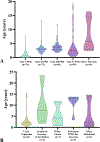DICER1-Related Tumor Predisposition: Identification of At-risk Individuals and Recommended Surveillance Strategies
- PMID: 39400264
- PMCID: PMC11649450
- DOI: 10.1158/1078-0432.CCR-24-1532
DICER1-Related Tumor Predisposition: Identification of At-risk Individuals and Recommended Surveillance Strategies
Abstract
Purpose: DICER1-related tumor predisposition increases risk for a spectrum of benign and malignant tumors. In 2018, the International Pleuropulmonary Blastoma (PPB)/DICER1 Registry published guidelines for testing- and imaging-based surveillance of individuals with a known or suspected germline DICER1 pathogenic or likely pathogenic (P/LP) variant. One of the goals of the Registry is to continue to refine these guidelines as additional data become available.
Experimental design: Individuals were enrolled in the International PPB/DICER1 Registry, the International Ovarian and Testicular Stromal Tumor Registry, and/or the NCI Natural History of DICER1 Syndrome study.
Results: Review of participant records identified 713 participants with a germline DICER1 P/LP variant from 38 countries. To date, 5 cases of type I and 29 cases of type Ir PPB have been diagnosed by surveillance in enrolled individuals. One hundred and three individuals with a germline P/LP variant developed a primary ovarian Sertoli-Leydig cell tumor at a median age of 14 years (range: 11 months-66 years); 13% were diagnosed before 8 years of age, the current age of onset of pelvic surveillance. Additionally, 4% of Sertoli-Leydig cell tumors were diagnosed before 4 years of age.
Conclusions: Ongoing data collection highlights the role of lung surveillance in the early detection of PPB and suggests that imaging-based detection and early resection may decrease the risk of advanced PPB. DICER1-related ovarian tumors were detected before 8 years of age, prompting the Registry to recommend earlier initiation of ovarian surveillance with pelvic ultrasound beginning at the time of detection of a germline DICER1 P/LP variant.
©2024 American Association for Cancer Research.
Conflict of interest statement
Figures



References
MeSH terms
Substances
Supplementary concepts
Grants and funding
LinkOut - more resources
Full Text Sources
Research Materials

